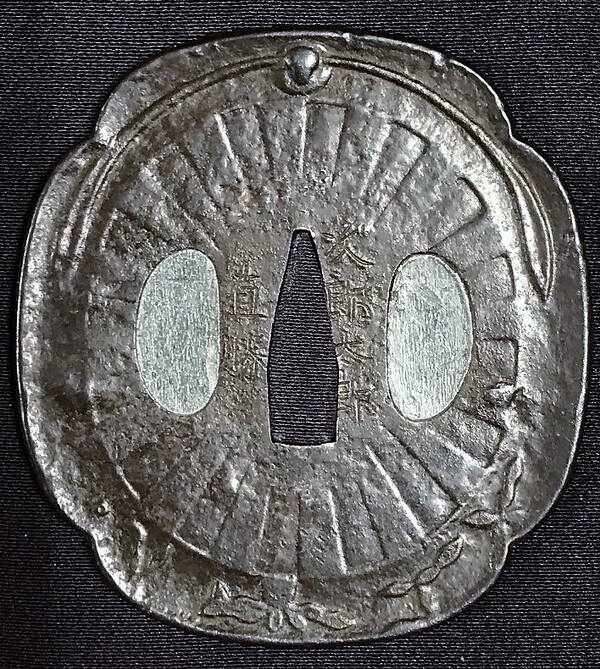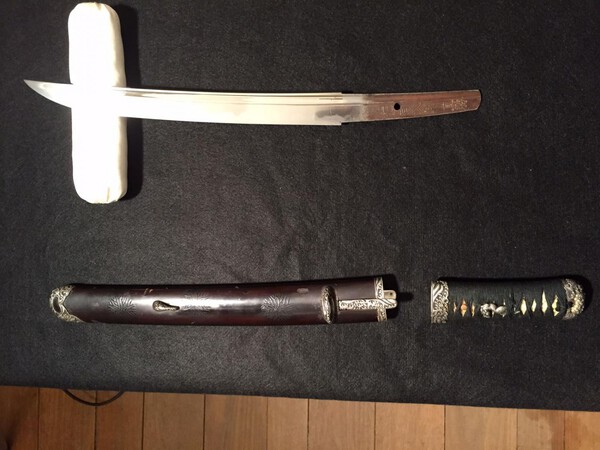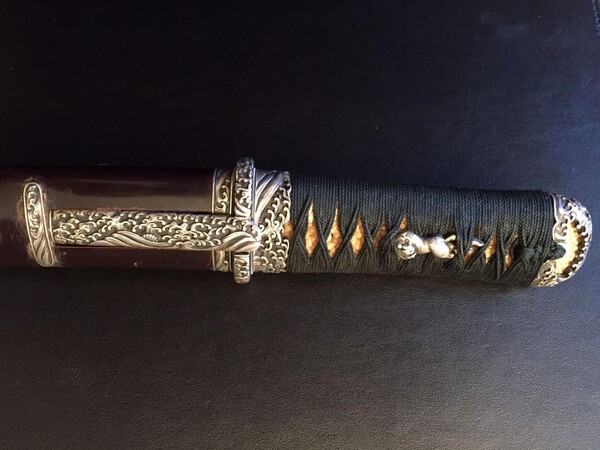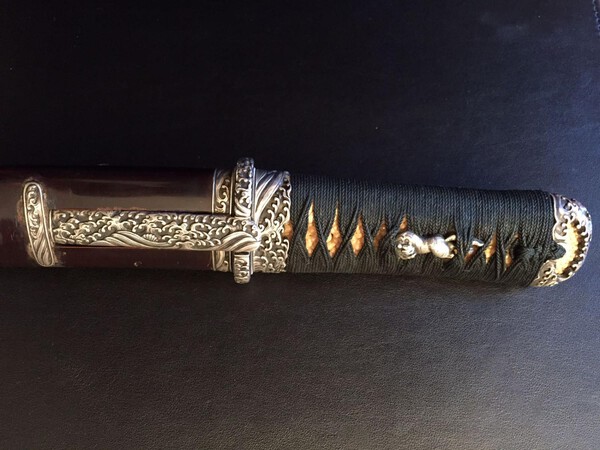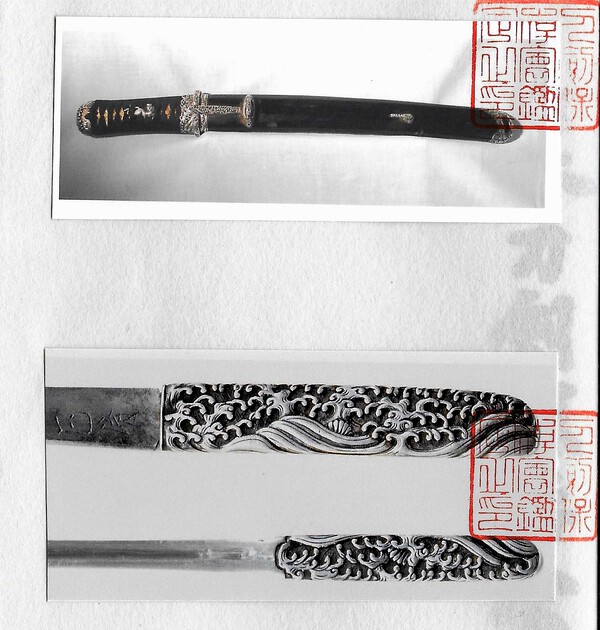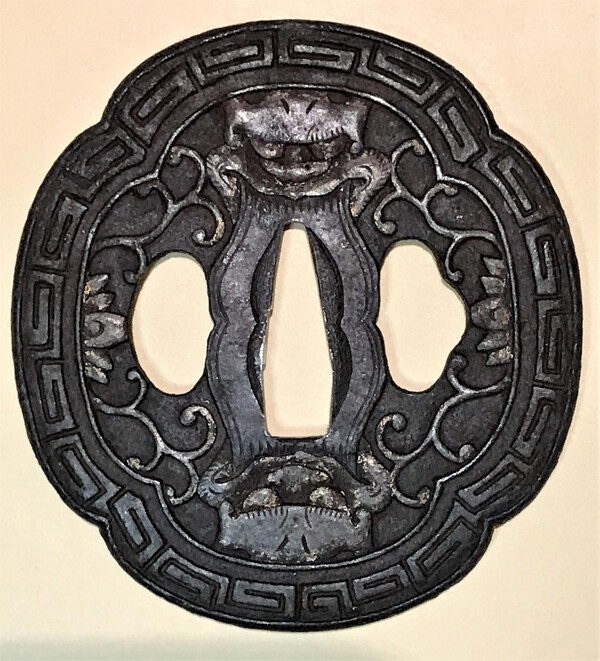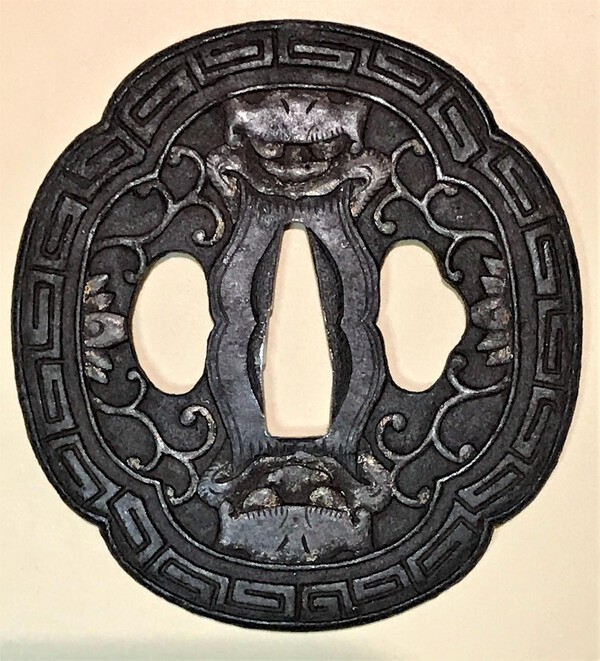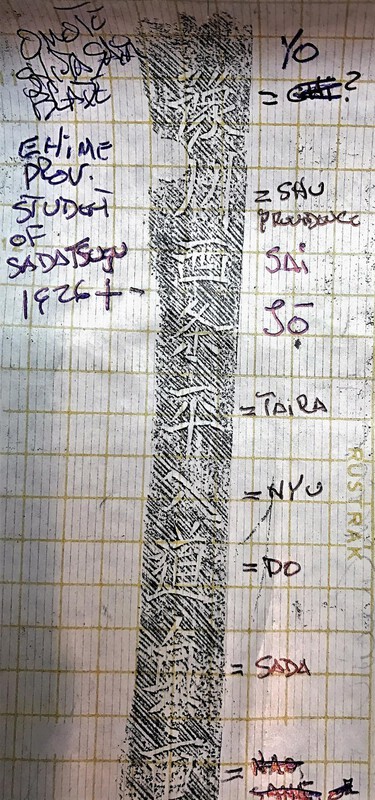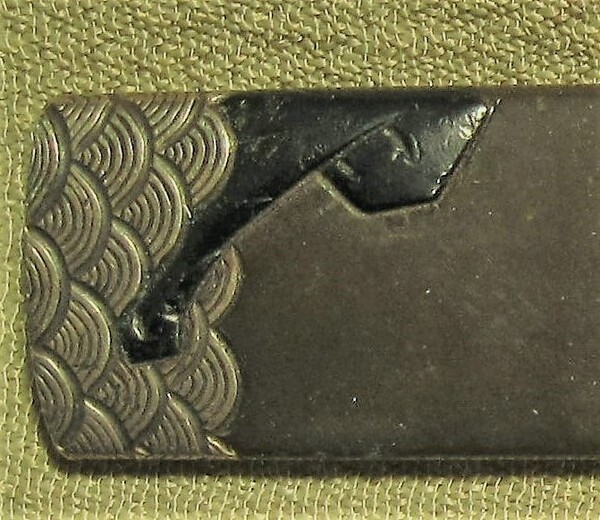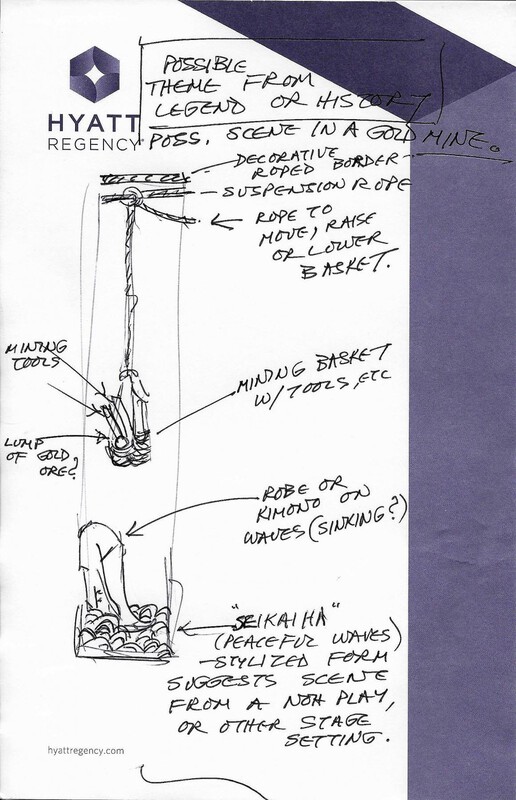-
Posts
703 -
Joined
-
Last visited
-
Days Won
4
Everything posted by Ron STL
-
This may be in the wrong category but... We were discussing where to have antique Japanese arrow shafts properly re-fletched. This is to go with an old bow all that goes with it. The fletching on the arrows are long gone. Anyone know of a reliable place to have this work done, traditionally? USA or elsewhere? Thanks RonSTL
-
Rainy day in St. Louis, a good day to post a couple more rabbit tsuba. The one with the rabbit looking up at the moon is signed: Kii ju Masayoshi, and mokume grained plate. The other is by shinshinto swordsmith Jirotaro Naokatsu. It is an unusual design rarely seen on his tsuba. It has a long-eared rabbit set into the motif. Ron STL
-
Thanks Ian, good to know it's still in loving hands. Always wanted to uncover the St. Louis history, who presented it as a gift, but an impossible task. Ron STL
-
Not sure if I'm coming in late on this old original posting about the boxed (hakogaki) kikuchi yari, but is that yari residing in the UK or perhaps came out of the UK? The one I'm remembering was last in the UK and once featured in an article in the British Token Society Program newsletter. If so, I'd like to hear of it's whereabouts. The yari I'm remembering came out of St. Louis back in the 1970's and was offered at a Chicago show. That yari was a gift to someone of importance from a visiting Japanese individual during our 1904 World Fair. I wanted it so bad but couldn't afford the price at that time. Perhaps this is a different yari...really curious to find out about it. Ron STL
-
What I have in silver is the koshirae for a Jirotaro Noakatsu tanto. This was discussed here last January and I ended up buying the mounted tanto. Fittings are beautiful and the tanto itself is nothing to sneeze at. Didn't need to spend the money but when you feel good doing so, it must mean you did the right thing. Koshirae is papered but translated, they really don't say much other than what eyes can see. Ron STL
-

Help With Sukemune Ura (Date) Translation
Ron STL replied to Ron STL's topic in Translation Assistance
Hmmm, interesting suggestions. I can see on the date where the year would be GO and not SAN but I'm not so sure what follows is as Steve suggested. And as for the last four kanji, I can see this perhaps being a name but can't see why a name would follow the date. Something like what John suggested would seem to make more sense, sort of like one would find on a shinshinto yari or sword. I sure wish my friend who owns this would find a good camera (or cell phone) to take a good picture of this thing. He should go ask the teenager next door to take care of this; I'll have to suggest that. Meanwhile, it is interesting to learn what others "see" in the inscription. The sort of thing that makes us look closely at what's on a nakago and find it interesting to understand it. Been doing that for sixty years! Ron STL -
Photos show rough rubbings made of the mei from a friend's yari signed SUKEMUNE SAKU. I've enlarged it to help in seeing the kanji. I see the date KAEI 3 (1850) followed by (?) and NEN 7TH MONTH 6TH DAY followed by four unidentified kanji. One of those is KATSU but I can't connect these to understand what's there. Asking a lot from a poor rubbing but maybe one of you can complete the date side translation. Spent quite a while on this without success. My friend who owns the yari figured out the 1850 date but insists the nakago is much older, but I suspect that is the result of not being kept very well. Help would be appreciated very much. Ron STL
-
Thanks Guido, I'll familiar myself with the fellow. We should be in touch sometime...think how long ago it was when we first exchanged letters (manual typewriters). Ron STL
-
-
Hopefully I didn't post this earlier. Here is an interesting namban tsuba that was acquired at a Chicago show. Its motif is very symmetrical with the primary feature being -- my question -- what I think is an oni or demon. Notice the seppa dai shape which almost appears as his tongue. A very similar example is in John Lissinden's book on Namban tsuba, plate 8. Another but not quite so alike is on plate 10. Plate 8 is from the Nottingham Museum and I did check the little catalogue of years ago, but found nothing. It would be interesting (to me, at least) to get more opinions on this. Your thoughts on this? I'll have this tsuba at the upcoming SF show if anyone is interested to see it in hand. Not a treasure tsuba, but interesting nevertheless. Ron STL
-
Thanks Tom, everyone, for solving this puzzle. I wondered if the one inscription might be a specially forged one, but couldn't home in on that. My local friend was visiting friends several states west and was able to examine this sword and two other lesser ones owned by a friend. The swords have been stuck away in a closet and never looked at before. My friend wants to buy at least the Sadashige but we all know how this can go (back into the closet). I do hope it gets rescued and taken care of but right now it is a waiting game. I'll pass on your interest, Stephen.
-
I've always admire good quality Yoshiro mon sukashi tsuba, especially when they carry the inlay over the edge of the tsuba. While I have eight or so of these, I finally got my first signed Yoshiro two years ago at the Chicago show. It is signed simply: Yoshiro saku. One day I hope to find one with the artist's name included...maybe. I must admit that calling a tsuba simply Yoshiro or Kaga Yoshiro or Bizen Yoshiro work continues to confuse me and I don't feel totally confident in being that specific with my judgement. On the attached signed example, the color is a little off in this shot but you can read the mei. Ron STL
-
The ura (date side) of this sword by Sadashige has an additional inscription which I can not figure out. The date is the year 2600 (1939 or 1940) what else has been put on this nakago??? I recognize a few kanji but can not put them together. Not a very good rubbing but all I have on hand. A friend brought this over on Saturday asking for help translating the mei, etc., but I wasn't much help in this case. Thanks! Ron
-
Thanks for your thoughts on this kozuka. I've taken more photos of it to show detail. Color is a bit off, the base plate being more shibuichi, but the detail shows up. I find it interesting that some of the design is carried over to the back of the kozuka. Notice the shakudo "whatever" and water is carried onto the side of the kozuka. John, I'm unfamiliar with the tale you mentioned, but perhaps these photos will help. You can see the items in the sack, one does look like a pick. Interesting kozuka. I hate with close-ups show too much (scuffs, wear) but in the hand the kozuka condition appears very good. Ron STL
-
Does anyone know what tale is represented on this kozuka? The kozuka is papered many years ago (my first papered kozuka) to Kaga Goto. I've never understood what is represented on the kozuka but always loved the beautiful design. During our KTK convention held prior to last week's Chicago show we discussed the kozuka. David Pepper sketched the design and added some comments of what he thought was represented, but further study was needed to truly identify the motif. Attached, are a couple scans from the origami (in case my question is there) and David's sketch and notes. Perhaps someone out there recognizes just what tale goes with this design. Lovely kozuka as one would expect from Kaga Goto. Ron STL
-
Hope to meet some of you guys (and gals) on NMB in Chicago. I think most of us KTK (Kokusai Tosogu Kai) members will be found towards the back half of the room, right side area. I pulled out some nice swords to put out for sale and may have space to lay out a few "show and tell" items for study. Always feel free to ask to see such under-the-table sharing items, a good way to see some nice quality things. (I'm bad about asking about these myself, my fault.) Also, don't miss the special events put on by the NBTHK American branch and others. Takes one away from the showroom but are always learning experiences! Ron STL
-
Grey, I've never read your guidelines before and your advice with books (and I liked your thoughts on remounting gunto mounted swords, regarding effect on value). All such good advice on handling books. I believe it was Arnold Frenzel who decades ago suggested to not "thumb through" a book or even page through, in the usual placement of one's fingers. After years of this the fingers will often "dirty" pages in that spot. Those "thick" taikan can so easily be damaged (the spine) if not opened correctly. Hope everyone takes not of your advice! Ron STL
-
Thanks for the link to earlier discussion. I find it fascinating; must save this information to my file on the yari. Perhaps one or so of these yari will be found at the Chicago show next week? Ron STL
-
I had to go back to Knutsen and check out mijika yari, but can not find that reference again. Attached shows "Figure 21, Su-yari forms" from the book that shows this shape. It is described as: I-cho-yari or ginanbo-yari. These blades are usually 4-sided with a very blunt shaped tip that is intended to punch a hole through armour..." I took a couple photos of three "short yari" including the stubby shaped I-cho-yari (which is, I guess, one name for the shape). Of the other two yari, the middle one is signed long...Chikuzen...Nobukuni and the other, Chikuzen Yoshikane. Lovely yari with surprising hataraki. Ron STL
-
I suspect this is a 4-sided yari and as BaZZa said (hi mate) it would be made for piercing armor. I have a similar yari with that somewhat subby tip signed by "Biyo Osafune ju nen Yokoyama Ise no kami Sukehira." It is called MIJIKA yari by Knutsen. Ron STL
-
So-called Namban tsuba have always interested me to some degree, if they are not just the run-of-the-mill mass produced version. Today, I have only a handful of fine examples in my collection Fred Geyer has a good number of these tsuba. The one you found that was made for a rapier is certainly worthy of study. Fred always has fine quality in his collection! Another source of study on these European-style namban was written by Peter Bleed a few years ago and published. I'm sure a Google search would find it for you, if interested. Ron STL
-
My first impression when seeing the photos reminded me of an osuriage wakizashi the recently was given Tokubetsu Hozon to Enju den. Ron STL
-
Finally looked at the eBay kikuchi yari listing and thought it looked rather interesting. Lots of strong and distinct nioi showing all along the hamon. It would be interesting to buy reasonable and spend a few bucks to repolish it with new habaki, etc. Those appear to be the old "White" papers from the NBTHK that was the first level of papers issued. I think they were phased out around 1970, thereabout. Although the nakago doesn't appear cut off, it probably was a yari with a long nakago, made into a tanto. Might be a fun project for a younger collector. I myself have a similar kikuchi yari shortened into a tanto. Had it for many years and still enjoy looking at it. Ron STL
-
Always a sad day when an active and serious collector passes. What a nice tribute to have so many friends expressing such fond memories. Ron STL


